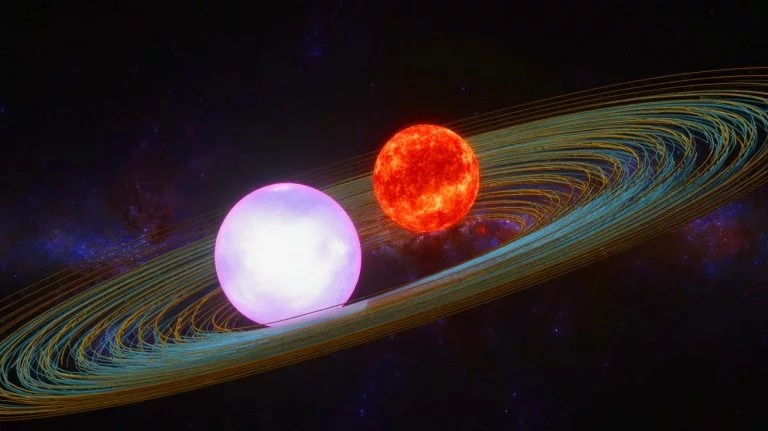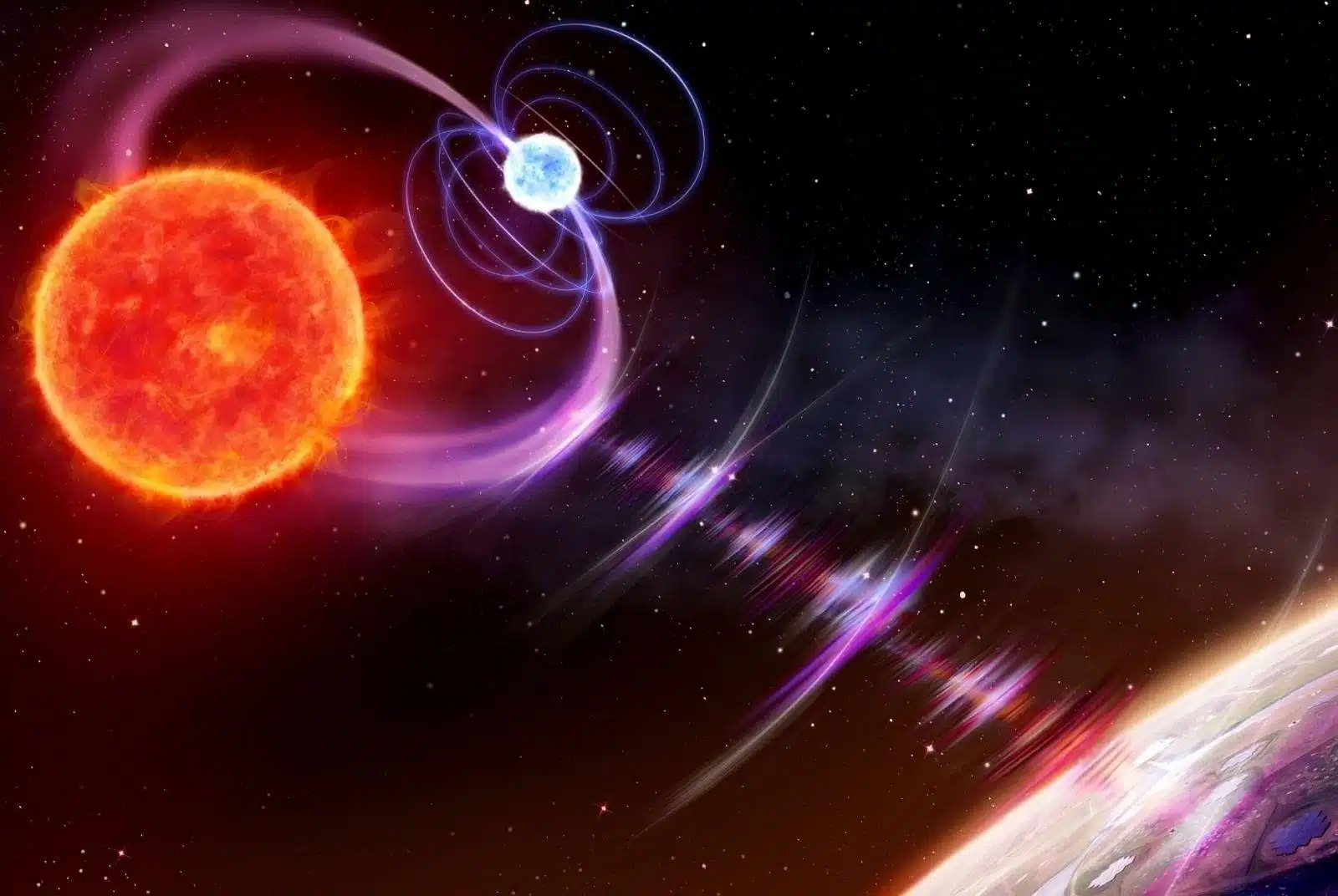| IN A NUTSHELL |
|
The universe is a vast and mysterious expanse, full of phenomena that continue to intrigue scientists and astronomers. Among these phenomena is a series of radio signals that have been puzzling experts for over a decade. Originating from the constellation of Ursa Major, these signals repeat every two hours, challenging previously held astronomical theories. Detected by the LOFAR radio telescope, these signals differ from the known fast radio bursts (FRBs), as they last several seconds and occur with remarkable regularity. This article delves into the source of these enigmatic emissions and their implications for our understanding of the cosmos.
A Binary System with Intense Magnetic Interactions
At the heart of this cosmic puzzle is a binary system known as ILT J1101, consisting of a white dwarf and a red dwarf in a tight orbit around each other. Their complete revolution takes just 125.5 minutes, during which their magnetic fields collide, producing radio impulses detectable from Earth. Optical observations have confirmed the presence of these two stars, with the motion variations of the red dwarf measured through spectroscopy revealing the gravitational influence of the otherwise invisible white dwarf companion.
This discovery marks a significant breakthrough, as it was previously thought that only neutron stars could emit long-duration radio pulses. The ILT J1101 binary system demonstrates that other compact objects, like white dwarfs, can also generate similar signals. This finding not only expands our understanding of binary star systems but also challenges existing models of stellar magnetic interactions.
A Cosmic Mystery with Major Implications
The regular radio pulses from ILT J1101 raise numerous questions about their origin. Are these emissions solely from the magnetic field of the white dwarf, or do they result from the interaction between the two stars? Researchers are actively investigating these hypotheses while searching for similar systems that could shed light on this phenomenon.
This discovery could provide insights into the origins of some FRBs, those rapid radio bursts that remain poorly understood. It illustrates that binary systems with dead stars can generate powerful and regular radio emissions. Astronomers are eager to find other examples, hoping these will help unravel the complexities of such cosmic occurrences. Future research involves studying the system’s ultraviolet emissions, which could reveal the temperature and history of the white dwarf, offering invaluable clues to solve this cosmic mystery.
Potential Insights into Fast Radio Bursts
The nature of fast radio bursts has long eluded scientists, but the findings from ILT J1101 could offer new perspectives. By understanding how binary systems like ILT J1101 produce radio waves, scientists can explore whether similar mechanisms might be at play in other parts of the universe. The fact that a white dwarf-red dwarf system can produce such signals opens the door to reevaluating the sources of FRBs.
With the potential to revolutionize our knowledge of radio astronomy, these findings suggest that several other compact binary systems might be waiting to be discovered. This prospect excites astronomers, as each system could provide unique data on magnetic field interactions and stellar evolution, ultimately contributing to a broader understanding of our universe’s dynamics.
The Role of Advanced Telescopes in Modern Astronomy
The detection of the signals from ILT J1101 underscores the importance of advanced telescopes like LOFAR in modern astronomical research. These instruments allow scientists to observe the universe with unprecedented precision, capturing phenomena that were previously invisible. The capabilities of such telescopes are crucial for identifying and analyzing rare cosmic events, leading to groundbreaking discoveries.
As technology continues to advance, telescopes will become even more powerful, enabling astronomers to delve deeper into the mysteries of the cosmos. This progress will not only enhance our understanding of known phenomena but also uncover new ones, pushing the boundaries of what we know about the universe. What other secrets might these powerful tools reveal in the coming years?
The recent discoveries from ILT J1101 remind us of the vastness and complexity of our universe. They challenge existing theories and open new avenues for exploration in the field of radio astronomy. As we continue to unravel these cosmic mysteries, what other extraordinary phenomena might we encounter, and how will they reshape our understanding of the universe?
Did you like it? 4.6/5 (28)








Wow, this is mind-blowing! Could this be the start of a new era in astronomy? 🤯
Is there any chance these signals could affect Earth in any way?
So the universe just got even more complicated, huh? 😅
Could this discovery help us understand fast radio bursts better?
I wonder if our technology will ever be advanced enough to send signals back.
This finding challenges a lot of what we thought we knew about space. Amazing!
Why are these signals repeating every two hours? Is it like a cosmic clock?
Is this phenomenon unique to Ursa Major or could it occur elsewhere?
Great insights! The universe is more mysterious than we could ever imagine. 🌌
What does this mean for the search for extraterrestrial life?
I’m no astronomer, but this sounds like the plot of a sci-fi movie!
How reliable are these observations? Could there be an error in data? 🤔
I love reading about new discoveries in space. Keep up the good work!
What if this is just the universe’s version of a “pocket dial”? 😂
The more we learn, the more questions we have. Science is truly never-ending.
Can other telescopes detect these signals, or is LOFAR unique in this capability?
How soon before we can study similar systems in other galaxies?
Do the stars’ magnetic fields have any impact on their surroundings?
This makes me want to become an astronomer! Fascinating stuff. 🤩
Is there any risk of these signals being misinterpreted by other researchers?
The universe is a crazy place. Who knows what other surprises are out there?
Can these findings be applied to improve our telecommunications technology?
Interesting read, but it’s all a bit over my head. 🤷♂️
Will future telescopes be able to provide more detailed data on such events?
This is a real breakthrough. Kudos to the scientists involved! 👏
Are these signals a regular occurrence, or is this a one-time discovery?
This article is fantastic, thank you for sharing such intriguing information!
How do scientists differentiate between signals from white dwarfs and neutron stars?
Are we sure it’s not aliens trying to communicate with us? 👽